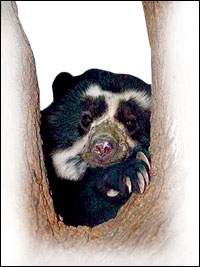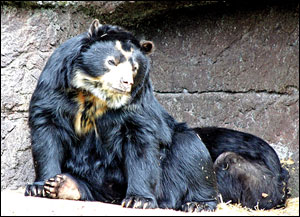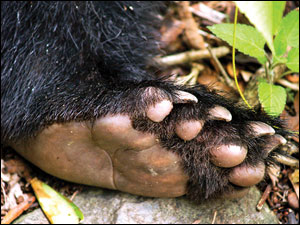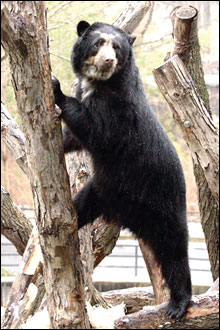|
Nature trail Spectacled bears?
Bears. Be they grizzly bears, polar bears or sloth bears, their
rolly-polly and cuddly appearance never fail to appeal to us. After all,
it's one of them that is responsible
|

They climb trees over 15 metres in height. |
|

A species under threat. |
for the origin of the teddy bear! So today, let's venture into the
fascinating world of bears for a while to check out on one of the many
species that we, in this part of the world, may not be so familiar with.
By now, you must be already curious as to whether this bear species
is in anyway connected to the spectacles we humans wear to be so named.
Of course not, but this particular species has markings around its eyes
that resemble spectacles! And naturally, it is known as the spectacled
bear. But, it is also known as the Andean bear (Tremarctos Ornatus).
The only representative of the Ursidae family which inhabits South
America, the spectacled bear has a wide geographical range.
It occupies a large diversity of habitats with altitudes ranging from
250 to higher than 4,000 metres above sea level, in the Andean Mountains
of Venezuela, Ecuador, Bolivia, Colombia and Peru. Isolated sightings
have also been recorded in the Southeast of Panama.The spectacled bears
are usually black in colour, but some individuals have fur coats in
shades of brown. Apart from the white or yellowish markings around their
eyes which gave them their name, similar markings found in the snout,
chest and neck areas are also distinguishing characteristics of these
animals. The shapes and extension of these markings differ among
individuals and according to the experts, it is not so uncommon to see
spectacled bears without specs - meaning some bears have fully black
faces with no markings at all!
These relatively small species of bears which are native to South
America, generally live solitary lives. They are very rarely seen
together unless they are new mothers.
|

Their claws are well adapted for climbing |
As in most other species, the males of spectacled bears too are much
larger than the females. On average the bears weigh between 80 and 125
kg, but there have been records of male bears that weigh as much as 175
kg. The average height is said to be 76 centimetres while the average
length from head to body is between 130-190 centimetres.These bears have
claws that are well adapted for climbing and when foraging for food,
they have been reported to climb trees over 15 metres in
height.Primarily vegetarian, these bears survive on mostly fruits, sugar
cane, nuts and leaves, especially palm leaves. But, as they are not
strictly vegetarian these bears occasionally catch birds, reptiles and
rodent. In fact, even though these bears are more vegetarian than other
bears, they are known as the biggest carnivores of South America because
they occasionally eat meat which only comprises about five per cent of
the diet.
Would you believe that these bears are considered as a vital source
of seed dispersal in the forests?
If ever you encounter a spectacled bear you need not be mortified
because it will not be aggressive. Generally when confronted by humans,
these bears react in a docile, but cautious manner. They'll only react
if the intruder is seen as a threat, especially by mothers with
cubs.Females are capable of reproduction by the time they are about four
years of age.
They give birth to one or two cubs weighing 300 - 500 grams just
before the onset of the fruit season; November through February. The
gestation time (pregnancy period) is highly variable and ranges between
five and eight months or a little longer.The cubs stay with their
mothers for six to eight months before venturing out on their own.

Their ability to survive in the wild would solely depend on how well
their mother taught them the necessary survival skills. The loss of
rainforest habitat and illegal poaching for the wildlife trade have
posed a major threat to the survival of these cute bears. Today they are
listed as vulnerable in the ICUN Red Data Book.
So, yet another species is slowly being eliminated. But we cannot let
animal species disappear from our Earth like this. There are too many
animals who are threatened with extinction today and it's time we
stopped destroying their habitats and killing them for trade. Let's hope
the spectacled bears that are listed only as 'vulnerable' today won't
end up as near threatened in the near future.
Facts and Pix: Internet
**********
Fact file
* The markings around their eyes are unique to each animal and can be
used for identification of individuals.
* It is believed that fewer than 2000 to 2400 animals are existing in
the wild.
* These bears are known as ukuko, jukumari or ucumari, by the people
of the areas they inhabit.
* They are the closest living kin of the short faced bears that lived
long, long ago.
|

Average height is about 76cm. |
* The root word trem of their scientific name Tremarctos ornatus
comes from a Greek word meaning hole. Ardos is the Greek word for bear.
Tremarctos is a reference to an unusual hole found on the humerus
(the long bone of the upper arm). The second part of the scientific name
ornatus in Latin means 'decorated'. This refers to the tawny markings
that give the bears their English name.
* These bears are historically found from dry coastal deserts to rain
forests, to treeless alpine areas above 4,000 metres.
* Even though hibernation is common among bears, there are no
recorded examples of hibernation in this species due to the availability
of food throughout the year.
* Their survival has depended mostly on their ability to climb even
the tallest trees in the Andes region.
* When feeding, they bend branches and construct nests which serve as
both a feeding platform and a day time sanctuary.
* They have powerful jaws, strong teeth and excellent eyesight.
Perhaps, the spectacles help them see better!
* The gall bladders of spectacled bears are valued in Oriental
medicine and fetch high prices in the market.
********** |

